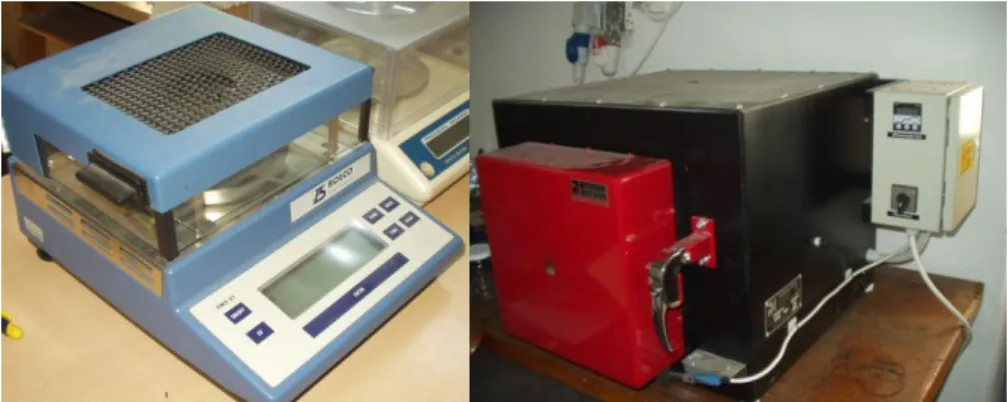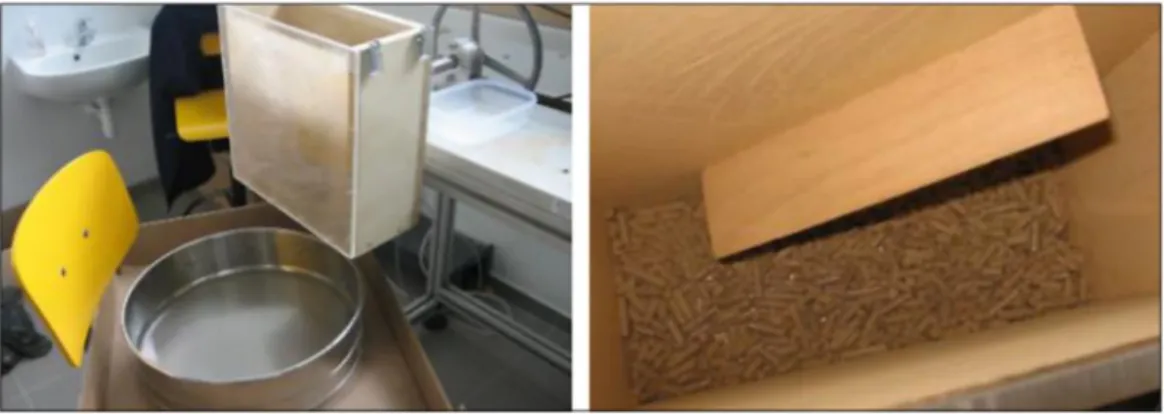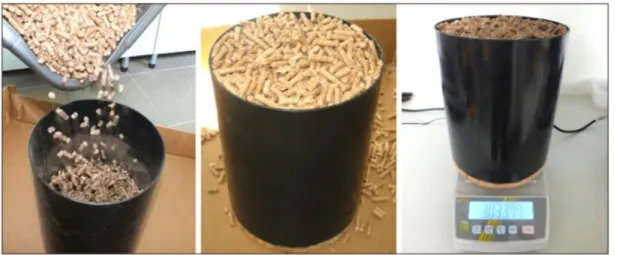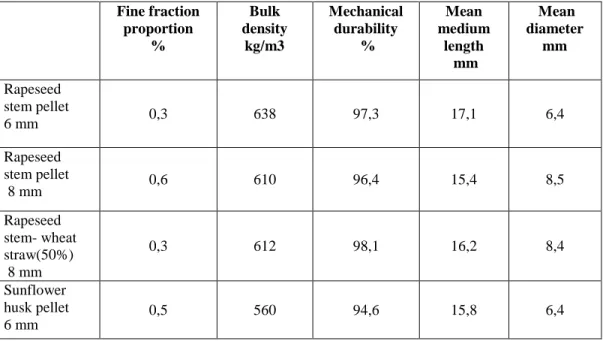DOI: 10.14232/analecta.2019.1.40-47
40
MECHANICAL AND ENERGY EXAMINATION OF DIFFERENT AGRIPELLETS
1Papp Viktória, 2Beszédes Sándor, 1Szalay Dóra
1University of Sopron, Faculty of Forestry, Bajcsy Zs. street 4., 9400, Sopron, Hungary
2University of Szeged, Faculty of Engineering, Moszkvai krt. 9., 6725, Szeged, Hungary e-mail:papp.viktoria@uni-sopron.hu
ABSTRACT
As an indirect consequence of climate change, the reduction of carbon dioxide emissions, the energy utilization of agricultural by-products will be increasingly emphasized in the future. Hungary has a large potential of agricultural residues of which is a big part could be used for energy purposes. Common feature of this by-products is that thay are originally difficult to handle and they have a small bulk density. Pellet production is one possible way to utilization, however the high ash content and low ash melting point cause problems in pellet burner equipments. Mixtures of different plant residues (wheat straw, rape seed stem, sunflower husk) and agripellets have different energetic and mechanical properties. Besides high ash content and low ash softening temperature, mechanical properties can also significantly affect the quality of pellets as well as the efficiency of firing. There were also significant differences in diameter, length, bulk density and mechanical durability of pellets.
Keywords: agri-pellet, rape seed stem, wheat straw, sunflower husk
1. INTRODUCTION
Since the Industrial Revolution, CO2 levels have risen from 180 ppm to over 400 ppm and other greenhouse gases such as methane and N2O are rising, which, according to several researchers has triggered an irreversible warming process [1]. In addition to environmental reasons, energy supply based on fossil resources in the European Union and in Hungary also leads to strong import dependency. Due to its soil and climatological features, Hungary has a large potential of biomass for energy purposes. In order to increase the share of renewable energies, the energetic utilization of biomass is a possible alternative.
Forestry, wood industrial and agricultural by-products are available in large quantities. The common feature of the raw materials is that they are difficult to handle in their original condition, their firing is problematic and they have low bulk density.
The pellet is a high-pressure energy compact, cylindrical granulate. It is characterized by high density (600-850 kg / m3) and compactness [2]. Diameter of pellets is usually between 5-10 mm, length 10-35 mm [Burján, 2010]. A common feature of agricultural by-products is that they have low bulk density, so transportation is not economical and firing is also problematic. The production of agripellet allows us to produce fuel that can be utilized in an automated way with good energy efficiency based on our previous studies[3].
The pellet sector has started to develop rapidly in Europe, and in recent years the number of wood pellet factories has been doubled, mainly using wood shavings as a by-product of wood industry. Due to increasing the share of renewable energies and the limited availability of wood-based stocks pellets are produced from agricultural by-products, mainly from straw and stems will play a greater role in the future.
These herbaceous plants residues are re-produced on arable land every year and have significant potential for energy utilization. The use of agripellets in the European Union is also steadily increasing, but it is still dwarfing compared to a higher quality wood pellet.
DOI: 10.14232/analecta.2019.1.40-47
41
There are several reasons for the slower spread of agri-pellets. The high ash content of the herbaceous plants and the low ash melting temperatures often cause problems in the burning systems. Melting and slagging temperatures of wood-based fuels are generally above 1000 °C degrees, around 1100-1200 °C degrees, in contrast, the herbaceous plants are melt around 600-850 °C [4,5,6,7,]. In addition, the energy characteristics and the heating value are significantly lower than in wood pellets[8].
Of the chemical components, the presence of lignin, pentosans, and protein greatly influences the properties of the pellets. The presence of lignin changes the bonding properties. It melts at a relatively low temperature of 140 °C, and later holds together the particles after compaction [9]. Protein content also plays an important role in the formation of pellets. The residence time, temperature and high pressure cause partial denaturation of proteins [10]. Caroll and Finnan studied chemical and physical properties of pellets by woody and herbaceous material, rapeseed straw, wheat straw, barley straw and energy crops, willow and mischantus reeds. According to their results, the upper heating value of rapeseed was 18.2 MJ / kg, the ash content was 5.3%. Different pellets were produced at 6 mm press hole with a small pelletizer (max capacity 150 kg / h). Among the investigated materials, the mechanical durabilitiy of Mischantus reed was 95,2% the rapeseed stem pellet was 95.8%, wheat and barley straw pellets were better 96.3% and 96.8%[11].
2. MATERIALS AND METHODS
Pellets produced under operational and laboratory conditions were also examined. Among the energy properties, the calorific value, the moisture content and ash content were determined. In the course of the experiments, a mixture of pellets of rape seed stem, wheat straw and sunflower husk were produced by experimental (Kahl type) pelletizing equipment. The rape stem utilization is justified by the fact that in recent years its production area has increased significantly in Hungary, in the year 2018 it was grown on more than 300 thousand hectares [12]. The amount of rape stem per hectare can be twice the weight of the seed. The largest area in the country is occupied by cereals, wheat and barley. Significant amounts of by- products, straw and stem are produced annually of witch a significant part could be use for energy purposes.
In the course of the tests, three types of agripellets were produced, a pellet with a 6 mm diamter press hole from a pure rapeseed stem, an 8 mm diameter hole with rape stem and with the addition of 50 % wheat straw. Pellets made from sunflower husk were produced under operational conditions in a pellet plant.
Among mechanical properties, the diameter and length of the pellets, the fine particle size and the mechanical durability were examined.
Determining the calorific value from an energy point of view is one of the most important issues. The higher heating value was determined by calorimetric measurements. The lower heating value can be calculated by using the following formula:
𝐿𝑜𝑤𝑒𝑟 ℎ𝑒𝑎𝑡𝑖𝑛𝑔 𝑣𝑎𝑙𝑢𝑒(LHV) =𝐻𝐻𝑉−(
2447∙(𝑈+9∙𝐻)
100 )
1+100𝑈 [𝑘𝑔𝑘𝐽] (1) HHV – Higher heating value of the test substance (measured value)
U - gross moisture content of the test substance [m /m%]
H - Hydrogen content of the test substance [~ 6 m /m%]
DOI: 10.14232/analecta.2019.1.40-47
42
Figure 1. IKA-C 2000 type Calorimeter
Ash content is an important for energy aspect, and it is also important for firing equipment design. The ash content of wood pellet is low, usually below 0.5 %, while agri pellets from herbaceous plants have a higher ash content of about 3 to 10 %. The ash content was determined by muffle furnace test. From a firing point of view, moisture content is one of the most important properties, since it is closely related to the heating value [13]. Determining the moisture content is also important because of the pelletization, if the wet content is too high or too low, the pellet will breaking and fall apart.
Figure 2. Moisture content analyzer and muffle furnace
The determination of the fine particle is an important aspect of the combustion technology of pellets. If the fine proportion is too high, problems may arise during combustion, the flue gas composition changes, efficiency decreases. A perforated sieve made in accordance with ISO 3310-2 should be used - according to MSZ EN 15210-1 - to sieved the pellet to determine the fine particle size (the so-called "crumb").
DOI: 10.14232/analecta.2019.1.40-47
43
Figure 3. Determining the fine proportion by sieving
From a sample of about 1.2 kg, the sieve is used to manually remove the crumb by a few circular movements, which can be calculated with the following formula:
𝐹 = 1 −𝑚𝑚𝐴
𝐸 [%] (2) where
F – Fine fraction proportion [%]
mE - sample weight before sieving [g]
mA - sample weight after sieving [g]
2.1 Mechanical resistance and durability of pellets (DU)
The mechanical durability of pellets is described in MSZ EB 15210-2 standard. The measurement was carried out by the self-developed equipment of the University of Sopron, Institute of Mechanical Engineering and Mechatronics in accordance with the standard. The 500 ± 10 g pellet, which had to be sieved and weighed on a 3.15 mm perforated sieve, was loaded into the pellet testing apparatus (shown in Figure 4.) and then rotated for 10 minutes at 50 ± 2 round/min the pattern. After the mechanical rotation, the pellet is filled into the sieve and weighted again.
Figure 4. Measurement of mechanical durability
DOI: 10.14232/analecta.2019.1.40-47
44
Determine the mechanical durability of the pellet using the two samples measured and the following formula:
𝐷𝑈=𝑚𝑚𝐴′
𝐸′ [%] (3) where:
Du – Mechanical durability (%)
m'E - Weight of pellets above 3.15 mm before mechanical treatment (after sieving) [g]
m’A - Weight of pellets above 3.15 mm after mechanical treatment (after sieving) [g]
2.2 Pellet length and diameter
In the case of pellets, it is an important requirement, based on the ENplus recommendation using EN 14961-2, to have an average length of between 3.15 and 40 mm. The length of the pellets can be influenced by many factors. The particle size, moisture, and above all the material composition. The tests should be carried out on all pellets in a sample of 80 to 100 grams using a simple caliper. Measuring uncertainty is of paramount importance in measuring length, since subjective determination of the center of measurement of length and other random measurement errors can result in a significant absolute error. According to the research of wood pellets published by Németh in 2014, the calculated total error was ± 1.66 mm (including the 0.02 mm error of the instrument)[14]. Its significance lies in the fact that in case of measured pellet types it is not practical to simply accept the results obtained as an average, but it is necessary to give the mean length values together with the measurement error [14].
Bulk (Volumetric) density ( "BD")
Bulk density is an important parameter in the transport of pellets. According to MSZ EN 15103, an analytical balance and a standard 5 liter tank are required for testing.
Figure 5. Measurement of bulk density
DOI: 10.14232/analecta.2019.1.40-47
45
Based on the following formula, this parameter can be calculated by taking the measured values into account:
𝐵𝐷𝑎𝑟=(𝑚2−𝑚𝑉 1)[𝑚𝑘𝑔3] (4) where:
BDar - volume density of the sample taken (moisture content) m1 - tank weight [kg]
m2 - total weight of the sample and tank (“saturated” tank weight) [kg]
V - tank volume [m3] 3. RESULTS
There was a significant difference in the mechanical properties of the pellets due to the different diameters and the mixture of different materials. The measurements were repeated three times, the average of the results being shown in Table 1.
Table 1. Mechanical properties of sunflower husk, rape seed stem and wheat straw blend pellets Fine fraction
proportion
%
Bulk density
kg/m3
Mechanical durability
%
Mean medium
length mm
Mean diameter
mm
Rapeseed stem pellet
6 mm 0,3 638 97,3 17,1 6,4
Rapeseed stem pellet
8 mm 0,6 610 96,4 15,4 8,5
Rapeseed stem- wheat straw(50%) 8 mm
0,3 612 98,1 16,2 8,4
Sunflower husk pellet 6 mm
0,5 560 94,6 15,8 6,4
The average medium length of the 8mm pellet was significantly lower than the 6mm rapeseed stem pellet.
The fine proportion of pure rapeseed stem pellets was higher than that of the blend pellets. Mechanical durability was also better for blend pellets, which is important from a firing point of view. If the proportion of small, fragmented fractions is too high, the efficiency may decrease. According to the quality requirements, the rapeseed straw pellets can be classified into EN-B category based on mechanical properties, while the mix pellet can be classified into EN A2 category. However, the ash content for each pellet exceeded the 3% allowed for the agripellets, which is only the EN-B category. Sunflower pellet has the highest calorific value among the samples tested. The outstanding calorific value is caused by residual oil in the husk.
DOI: 10.14232/analecta.2019.1.40-47
46
Table 2. Energy properties of sunflower husk, rape seed and wheat straw pellets
Wet content % Heating Value MJ/kg Ash content %
Rape seed stem pellet 9,4 16,3 5,2
Rapeseed stem- wheat straw (50%)
8,7 15,9 8,3
Sunflower husk pellet 8,9 17,9 3,1
4.CONCLUSIONS
There were significant differences in the mechanical properties of the examined pellets. The different press hole diameters and the different material composition also affected the results. Properties of pellets made from rapeseed stems was less favorable than wheat straw blends. The mechanical properties can significantly affect the firing parameters. In the future, flue gas analysis tests could be carried out to get information on efficiency and other firing parameters.
ACKNOWLEDGEMENT
The described work was carried out as part of the „Sustainable Raw Material Management Thematic Network – RING 2017”, EFOP-3.6.2-16-2017-00010 project in the framework of the Széchenyi 2020 Program. The realization of this project is supported by the European Union, co-financed by the European Social Fund.
REFERENCES
[1] National Atmospheric Administration (2017): Carbon dioxide levels rise at record pace for 2nd straight year - https://www.noaa.gov/news/carbon-dioxide-levels-rose-at-record-pace-for-2nd-straight-year [2] Z. Szamosi, K. Lakatos, Z. Siménfalvi, Az agripellet, mint megújuló energiaforrás vizsgálata, GÉP
Magazin, 63.évf/6, 2012, pp. 77.
[3] V. Papp, B. Marosvölgyi, A pellet mint megújuló energiaforrás előállítása, hasznosítása és energetikai értékelése, Energiagazdálkodás, 2013, pp. 21.
[4] P. Tóvári, B. Marosvölgyi, BIOMASSZA TÜZELŐANYAGOK TERMIKUS KEZELÉSÉNEK LABORATÓRIUMI MODELLEZÉSE, NYME KKK Ökoenergetikai főirány, Jelentés, 2011, pp. 12.
[5] Carborobot (2014): Pellet, Agripellet, Pelletfajták - http://www.carborobot.hu/HU/Pellet.htm
[6] V. Papp, B. Marosvölgyim, Research of energy balance of pellet and briquette production In:
Bioenergy and Other Renewable Energy Technologies and Systems, Bucuresti: PRINTECH, 2011, pp.
16-17.
[7] P. Toscano, F. Corinaldesi, ASH FUSIBILITY CHARACTERISTICS OF SOME BIOMASS FEEDSTOCKS AND EXAMINATION OF THE EFFECTS OF INORGANIC ADDITIVES, Journal of Agricultural Engineering, Vol 2., 2010, pp. 14.
[8] V. Papp, Energetikai pelletek előállításának és hasznosításának ökoenergetikai vonatkozásai, Doktori értekezés, Soproni Egyetem, 2018, pp. 67.
[9] J. E. G. van Dam, M. J. A. van den Oever, W. Teunissen, E.R.P. Keijsers, A.G. Peralta, Process for production of high density/high performance binderless boards from whole husk Part 1: lignin as intrinsic thermosetting binder resin-Industrial Crops and Products, 19, 2004, pp. 207–216.
DOI: 10.14232/analecta.2019.1.40-47
47
[10] F. J. Wood, The functional properties of feed raw materials and their effect on the production and quality of feed pellets-Animal Feed Science Technology, 18, 1987, pp. 17.
[11] J. Caroll, J. Finnan, Physical and chemical properties of pellets from energy crops and cereal straws, Biosystems enrineering, 2012, pp. 151-159.
[12]KSH(2019):Főbb mezőgazdasági növények termőterülete, Idősoros jelentés, http://www.ksh.hu/docs/hun/xstadat/xstadat_eves/i_omn007a.html
[13] B. Marosvölgyi, 2006, Szilárd, biomassza alapú tüzelőanyagok energetikai tulajdonságainak vizsgálata-http://docplayer.hu/12093734-Szilard-biomassza-alapu-tuzeloanyagok-energetikai-
tulajdonsagainak-vizsgalata-segedlet.html
[14] G. Németh, Kis teljesítményű faalapú pellet tüzelő berendezés környezeti hatásainak vizsgálata, Faipar, 62. évf., 2014




